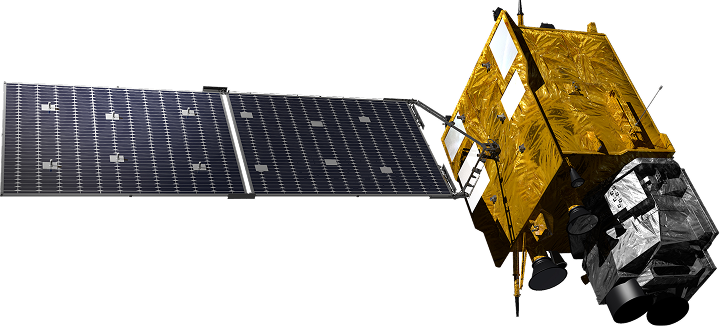

Geostationary Satellite (Cheollian 2A)
- Specification : Mass 3,507 kg
- Orbit : Geostationary (36,000 km)
- Mission : Meteorological/Space Weather observation
- Resolution: Visible channel 500 m/1 km. IR channel 2 km
- Launch date: December 5, 2018


As Korea’s first independently developed geostationary satellite, Cheollian 2A was developed to perform faster and more accurate meteorological observation than Cheollian 1 and establish independent geostationary satellite development capability and core technology independence.
Based on the experience of developing Cheollian 1 and Arirang satellites, from design to assembly and testing of the main body, KARI developed its model of mid-size geostationary satellites with a mission lifetime of 10 years and launch mass of 3.5 tons. Cheollian 2A applied precision control technology using a star tracker to provide the high-precision orientation accuracy required by the high-performance imaging payload in the geostationary orbit. Moreover, KARI has succeeded in localizing more than 25 types of satellite hardware such as satellite-mounted computer, payload connection devices, structures, multi-layered thin film insulation, power distributors, and pyro connection units. It has independently developed the flight software operating satellite hardware, transfer orbit operation technology for geostationary orbit movement after satellite launch, ground control system, image processing system, and observation image geometric correction system (INR).
Main body assembly, performance test, and launch preparation, except for the meteorological payload, were all performed with domestic know-how. Currently, only seven countries, including the United States, European Union, Japan, India, China, Russia, and Israel, have geostationary satellite technology.
Cheollian 2A is a faster, more accurate weather observation satellite. Compared to Cheollian 1, its spatial resolution is improved by four times. The observation period is significantly reduced to 10 minutes for the globe and 2 minutes for the Korean Peninsula, allowing 18 times faster observations. While Cheollian 1 was capable of black and white images only, Cheollian 2A can record color images. Moreover, the number of observation channels has more than tripled, and it can observe the same area three times faster.
With the launch of Cheollian 2A, Korea has greatly improved the weather observation and forecast accuracy and capability to monitor and forecast in the Korean Peninsula and Asian region. Cheollian 2A has 16 channels (4 visible, 2 near IR, and 10 IR) compared to 5 channels (1 visible and 4 IR) of Cheollian 1, more than tripling the number of types of serviced weather data from 16 to 52. Cheollian 2A can detect clouds and calculate cloud optical thickness, cloud particle size distribution, and potential precipitation. It can also detect aerosols, yellow sand, volcanic ash, and sulfur dioxide (SO2) and calculate particle size and optical thickness. Moreover, it can derive meteorological outputs such as sea level and surface temperature, snowfall, sea ice, and ocean currents.
| Subject | Cheollian 1 | Cheollian 2A | |
|---|---|---|---|
| General | Mission lifetime | 7 years | 10 years |
| Mission | Satellite communication, meteorological, and marine observation | Meteorological and space weather observation | |
| Orbit | Geostationary orbit (Satellite operating longitude: 128.2oE) | Geostationary orbit (Satellite operating longitude: 128.2oE) | |
| Mass | About 2.5 tons | About 3.5 tons | |
| Number of satellite platforms | 1 unit | 2 units (meteorological/space weather) | |
| Development Plan | Joint international development | Independent (system/main body/ground station) | |
| Budget | KRW 354.9 billion (one satellite) | KRW 720.0 billion (two satellites - Cheollian 2A and 2B) | |
| Payload | Configuration | Meteorological payload, marine payload, and Ka-band communication payload | Meteorological payload (AMI) and space weather payload (high-energy particle detector, satellite charging monitor, and magnetometer) |
| Resolution | Meteorological payload: 1 km (VIS) and 4 km (IR) (Regional and global observations)Marine payload: 500 m (local observation) | Meteorological payload: 500 M (0.6 μm) and 1 km (VIS), 2 km (IR) (Regional observation and global observation) | |
| Channels | Meteorological payload: 5 channels (1 visual and 4 IR)Marine payload: 8 channels (8 visual) | Meteorological payload: 16 channels (4 visual and 12 IR/near IR) | |
| System/Main body | Observed image position correction | Meteorological payload: < 56 uradMarine payload: < 28 urad | Meteorological payload: < 21 urad |
| Main body size | (At launch) 2.9 × 2.2 × 3.3 m (On orbit) 5.3 × 8.7 × 3.3 m | (At launch) 2.9 × 2.4 × 4.6m (On orbit) 3.8m × 8.9m × 4.6m | |
| Launch mass | 2.5 ton | GK2A : ~ 3.5 ton | |
| Power | 2,621 kW @ at the end of the mission | 2,633 kW @ at the end of the mission | |
| Orbit determination precision | 18km | 2km | |
| Orientation precision | Roll: 0.352°, Pitch: 0.352°, Yaw: 0.657° | Roll: 0.075°, Pitch: 0.075°, Yaw: 0.108° | |
| Data transmission rate | < 6.2 Mbps | < 115Mbps | |
Cheollian 2A’s meteorological payload is a world-class meteorological observation payload similar to the meteorological sensors mounted on GOES-16/17 in the US and Himawari-8/9 in Japan. The next-generation high-performance meteorological payload continues the meteorological observation mission of Cheollian 1, enhances up to date weather forecasting, provides monitoring of weather/environmental change as well as improved disaster forecasting.
Moreover, Cheollian 2A is equipped with the Korean Space Weather Monitor (KSEM), which observes space weather. The Space weather payload consists of a high-energy particle detector and a satellite charge monitor developed by Kyunghee University and a magnetometer developed by the European Space Agency (ESA). It can detect changes in high-energy particles and magnetic fields.